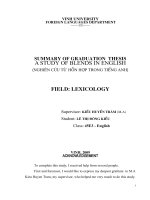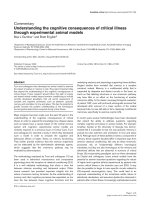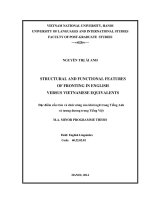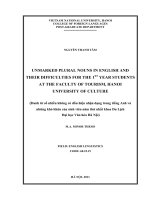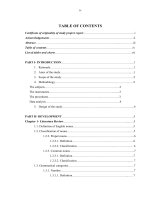ways of denoting characteristics through domestic animal metaphor in english = cách cách diễn đạt tính cách thông qua ẩn dụ vật nuôi trong tiếng anh tt
Bạn đang xem bản rút gọn của tài liệu. Xem và tải ngay bản đầy đủ của tài liệu tại đây (144.93 KB, 4 trang )
VIETNAM NATIONAL UNIVERSITY - HANOI
UNIVERSITY OF LANGUAGE & INTERNATIONAL STUDIES
FACULTY OF POST – GRADUATE STUDIES
*****************
HỒ THỊ THU TRANG
WAYS OF DENOTING CHARACTERISTICS
THROUGH DOMESTIC ANIMAL METAPHOR
IN ENGLISH
(Các Cách Diễn Đạt Tính Cách Thông Qua Ẩn Dụ Vật Nuôi
Trong Tiếng Anh)
Minor thesis
Field: English Linguistics
Code: 60 22 15
Ha Noi, 2010
VIETNAM NATIONAL UNIVERSITY - HANOI
UNIVERSITY OF LANGUAGE & INTERNATIONAL STUDIES
FACULTY OF POST – GRADUATE STUDIES
*****************
HỒ THỊ THU TRANG
WAYS OF DENOTING CHARACTERISTICS
THROUGH DOMESTIC ANIMAL METAPHOR
IN ENGLISH
(Các Cách Diễn Đạt Tính Cách Thông Qua Ẩn Dụ Vật Nuôi
Trong Tiếng Anh)
Minor thesis
Field: English Linguistics
Code: 60 22 15
Supervisor : Dr. Hà Cẩm Tâm
Ha Noi, 2010
4
TABLE OF CONTENTS
Declaration i
Acknowledgements ii
Abstract iii
Table of contents iv
PART I: INTRODUCTION 1
1. Rationale 1
2. Aims of the study 2
3. Research question 2
4. Scope of the study 2
5. Organization of the study 3
PART II: DEVELOPMENT 4
Chapter 1: Theoretical Background 4
1.1. An overview of Cognitive Linguistics 4
1.2. An overview of Cognitive Semantics 5
1.3. Conceptual Metaphor Theory 7
1.3.1. Definition of Conceptual Metaphor 7
1.3.2. Domain and Mapping 8
1.3.3. Image – schema 9
1.3.4. Levels of Conceptual Metaphor 10
1.3.5. Types of Conceptual Metaphor 11
1.3.6. Some features of Conceptual Metaphor 14
1.4. Animal Metaphor and The Great Chain of Being Metaphor 15
Chapter 2: The Study 18
2.1. Research question 18
2.2. Data Collection 18
2.3. Analytical Framework 19
2.4. Analysis 20
5
2.4.1. Arrogance 20
2.4.2. Maliciousness 21
2.4.3. Selfishness/ Greediness 24
2.4.4. Stupidity 25
2.4.5. Loose moral 26
2.4.6. Obstinacy 27
2.4.7. Cowardice 28
2.4.8. Servility 29
2.4.9. Smugness 30
2.4.10. Aggressiveness 30
2.4.11. Despicableness 31
2.4.12. Mild-manner 33
.2.4.13. Tenaciousness 33
PART III: CONCLUSION 34
1. Conclusions 34
2. Implications 35
3. Suggestions for further research 36
REFERENCES 37
APPENDIX 40
